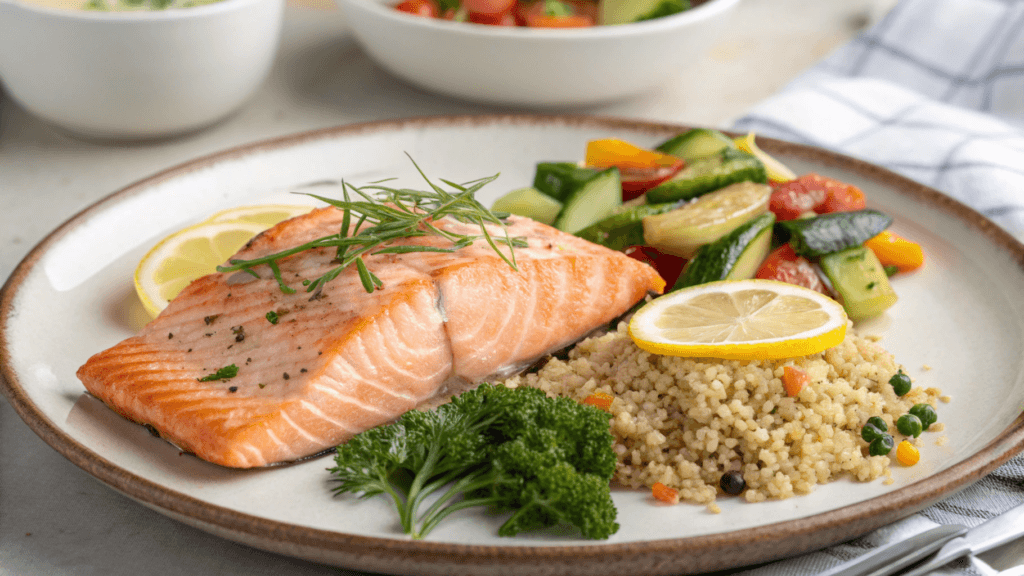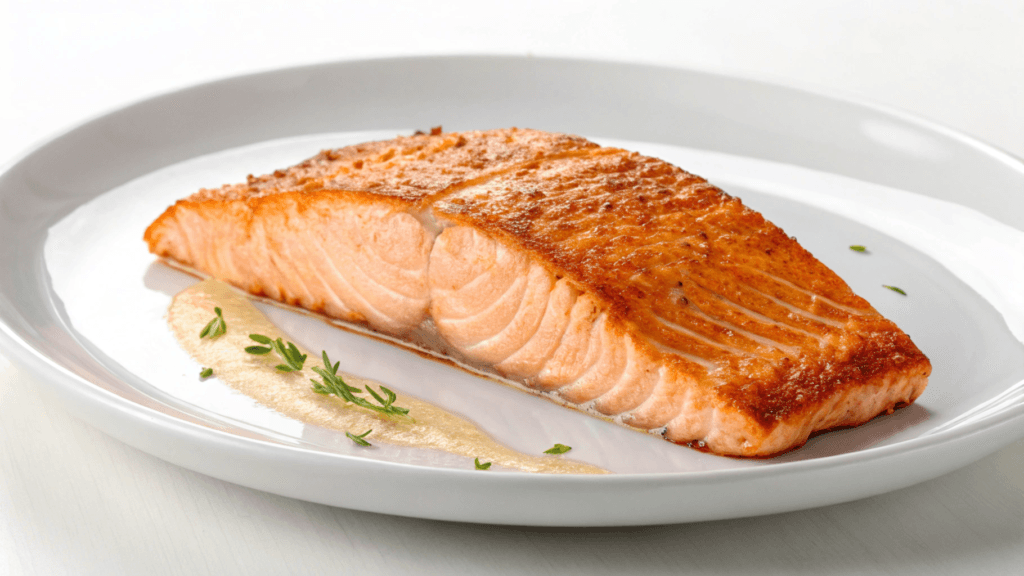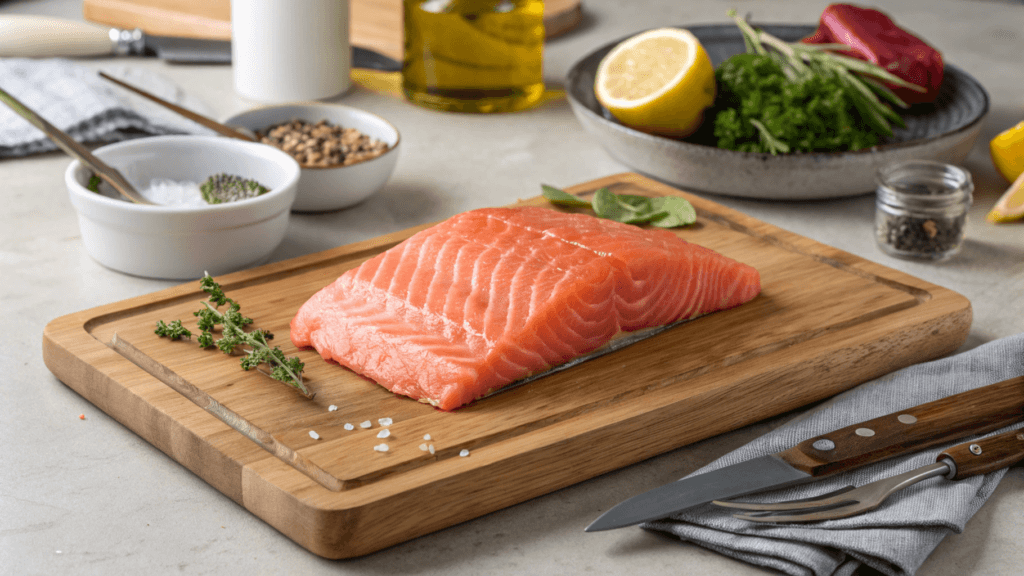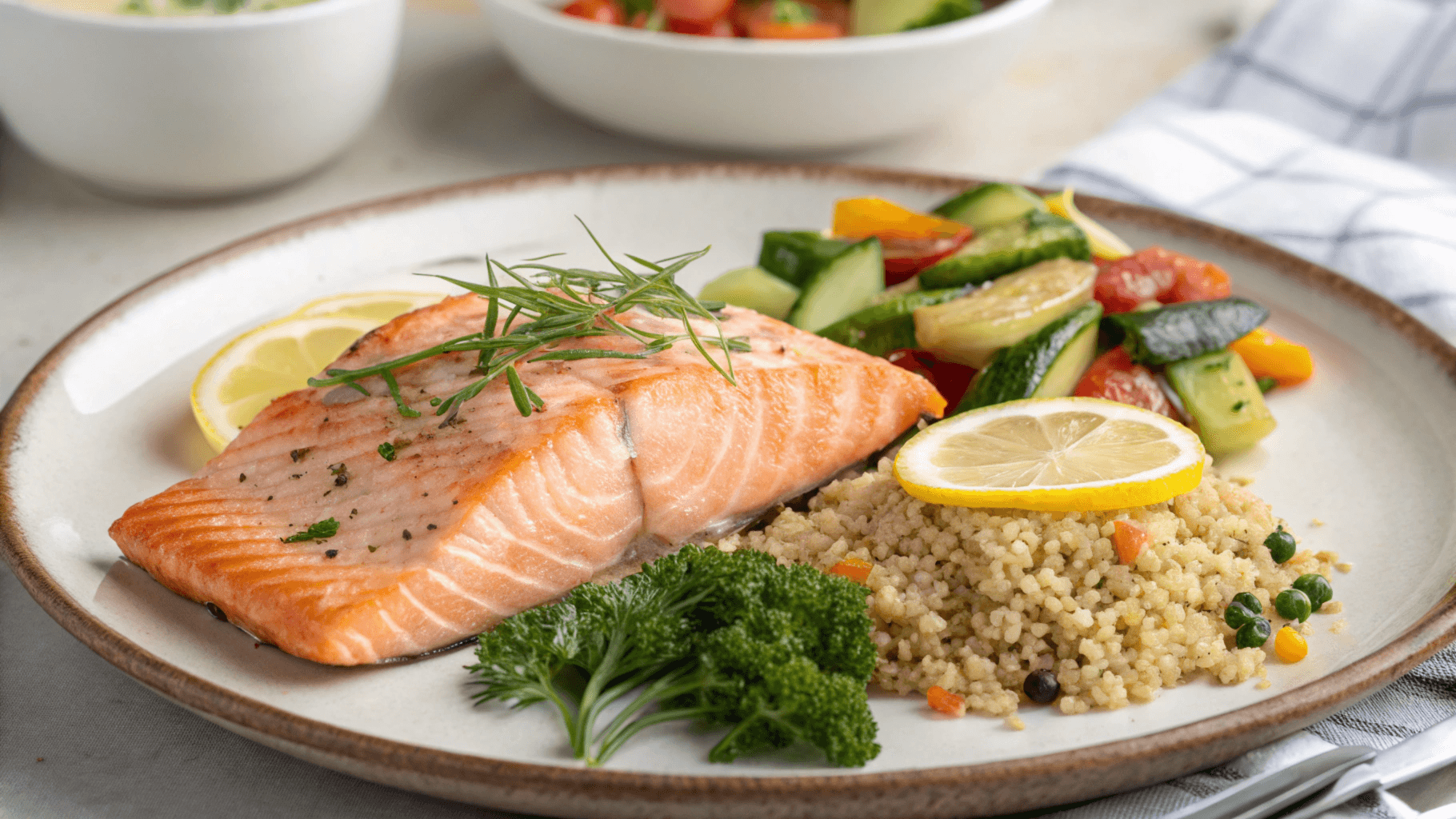One common question home cooks and chefs often ask is, “Is salmon safe at 125°F?” The ideal cooking temperature for salmon can be a topic of debate, especially when it comes to achieving a perfect balance between safety and flavor. While the USDA recommends cooking salmon to an internal temperature of 145°F, many chefs and food enthusiasts opt for slightly lower temperatures, such as 125°F, to achieve a more tender and juicy result. In this article, we will explore whether salmon is safe at 125°F, the science behind cooking salmon at this temperature, the risks of undercooking, and how to safely prepare salmon for optimal flavor and texture. For more details, check out this guide on salmon internal temp.

Table of Contents
Understanding Salmon Cooking Temperatures
Is salmon safe at 125°F?” The USDA recommends cooking salmon to an internal temperature of 145°F to ensure harmful bacteria and parasites are eliminated. However, many chefs and food enthusiasts prefer cooking salmon to 125°F for its tender, juicy texture and enhanced natural flavors. This lower temperature preserves the fish’s delicate, buttery quality, making it a favorite among those who enjoy medium-rare salmon. That said, it’s essential to weigh food safety concerns when cooking below the USDA’s guidelines. Learn more about the benefits and safety of salmon at 145°F.

The Science Behind Cooking Salmon at 125°F
Is salmon safe at 125°F? The answer lies in understanding how heat affects the proteins and fats in fish. When cooking salmon at 125°F, the heat is sufficient to cook the fish through while preserving its natural moisture. The fish’s internal structure remains delicate, as the proteins denature without overcoagulating, which helps retain its tender texture.
At 125°F, the salmon becomes opaque and flakes easily, while remaining juicy and flavorful. The risk of overcooking is minimized, and the salmon stays slightly pink in the center, which many people prefer. Although this temperature is below the USDA’s recommended 145°F, you can safely cook salmon at 125°F, as long as the salmon is fresh, properly handled, and cooked correctly.
Risks of Undercooking Salmon
One of the main concerns when cooking salmon at 125°F is the potential for undercooking. Undercooked fish can pose food safety risks, as harmful bacteria and parasites may not be fully eliminated at lower temperatures. For those wondering, “Is salmon safe at 125°F?”, the key factors are the freshness and quality of the fish, as well as proper handling and storage before cooking.
To reduce the risks associated with undercooking, it’s essential to source high-quality, fresh salmon and follow safe food handling practices. Additionally, freezing salmon before cooking can help eliminate potential parasites, making it safer to cook at lower temperatures. However, if you have concerns about foodborne illnesses, you should stick to the USDA’s recommended 145°F for added peace of mind.

Benefits of Cooking Salmon to 125°F
Cooking salmon to 125°F offers several benefits, especially for those who prefer a tender and moist texture. The main benefit of cooking at this temperature is that it allows the salmon to retain its natural oils, which contribute to its rich, buttery flavor. At 125°F, the fish remains delicate and juicy, as the heat doesn’t cause the proteins to dry out or become too firm.
Additionally, salmon cooked at 125°F has a slightly translucent center, which many people find desirable, as it maintains a melt-in-your-mouth quality. This temperature is especially popular for individuals who enjoy their fish cooked medium-rare. Furthermore, cooking salmon at 125°F helps preserve its healthy omega-3 fatty acids, which higher temperatures can destroy.
How to Cook Salmon to 125°F Safely
If you’re wondering “Is salmon safe at 125°F?”, the answer is yes—when you cook it correctly. To make sure the salmon reaches the right temperature and stays safe to eat, follow these guidelines:
- Use a Food Thermometer: The most reliable way to check the doneness of your salmon is by using a food thermometer. Insert it into the thickest part of the fish to ensure it reaches 125°F.
- Freshness Matters: Always source your salmon from a reputable supplier. Fresh, high-quality fish has a lower risk of harboring harmful bacteria or parasites.
- Freeze Before Cooking: Freezing your salmon at -4°F for at least seven days can kill parasites, making it safer to cook at lower temperatures.
- Proper Handling: Handle the salmon carefully to avoid contamination. Store it at the correct temperature and avoid cross-contamination during preparation.
- Cooking Methods: Methods like baking, grilling, or pan-searing are all effective for cooking salmon at 125°F. Slow and gentle cooking helps retain moisture and achieve the desired texture.
Common Questions About Salmon Cooking Temperatures
As you consider is salmon safe at 125?, it’s helpful to address some common questions about cooking salmon at various temperatures:
- Is it safe to eat salmon at 125°F?
Yes, provided the salmon is fresh, handled properly, and frozen before cooking to eliminate parasites. - Can you cook salmon at 125°F for a longer time?
Yes, slow cooking salmon at 125°F can help achieve a more consistent texture and flavor without overcooking it. - Why does the USDA recommend 145°F for salmon?
The USDA’s recommendation of 145°F ensures that harmful bacteria and parasites are eliminated, but it may lead to a drier texture. Cooking at lower temperatures like 125°F is safe when done correctly, but it requires proper handling. - Can I cook salmon to 125°F in the oven?
Yes, cooking salmon in the oven at a low temperature (around 125°F) is an excellent way to maintain its moisture and achieve a tender result. Just make sure to use a food thermometer to check the internal temperature. - What is the best method to cook salmon at 125°F?
Baking, grilling, or sous vide are all effective methods. Slow, consistent heat is key to achieving the perfect texture.
Popular Recipes for Cooking Salmon to 125°F
When considering Is salmon safe at 125?, many chefs and home cooks turn to popular recipes that maintain both flavor and safety at this lower cooking temperature. Salmon cooked at 125°F offers a delicate, moist texture and rich flavor, making it an ideal choice for various dishes. Here are a few of the most common ways to prepare salmon at this temperature:
- Baked Salmon: Preheat your oven to 125°F and bake the salmon for about 30-40 minutes, depending on the thickness of the fillet. This method ensures even cooking while keeping the fish tender and juicy.
- Grilled Salmon: Grilling at 125°F is possible with indirect heat. Cook the salmon for 10-15 minutes per side, checking for the internal temperature to reach 125°F.
- Sous Vide Salmon: Sous vide cooking allows you to set an exact temperature (125°F) for precise results. Cook the salmon in a vacuum-sealed bag for 30-45 minutes for tender, restaurant-quality fish.
By following these methods, you can cook your salmon to 125°F and achieve a delicious, safe meal.
Expert Opinions on Cooking Salmon at 125°F
Many culinary experts agree that Is salmon safe at 125? The answer largely depends on the quality of the fish and its handling. Renowned chefs often recommend cooking salmon at this lower temperature for a more flavorful and moist result.
Several experts believe that cooking salmon to 125°F brings out the fish’s natural oils, keeping it rich in flavor without overcooking. Salmon cooked at this temperature remains slightly pink in the center, which is preferred by many for a medium-rare texture. However, experts also caution that lower temperatures come with an increased risk of undercooking if the fish isn’t sourced properly or handled with care. For those asking, “Is salmon safe at 125°F?”, the answer depends largely on the quality and handling of the fish.
To ensure safety, it’s important to source salmon from reputable suppliers and follow correct food safety practices, such as freezing the fish before cooking to eliminate any parasites. If you’re unsure, cooking salmon to 145°F is always the safest choice.
Comparing Cooking Methods for Salmon
If you’re asking Is salmon safe at 125?, it helps to compare different cooking methods to understand how each one affects the final result. Various cooking techniques can bring out different textures and flavors in salmon while maintaining safety.
- Baking at 125°F: Baking salmon at this temperature is a slow method that ensures even cooking. The fish remains moist and tender, with minimal loss of natural oils.
- Grilling at 125°F: Grilling can be challenging at lower temperatures. Indirect heat is key, as direct grilling may dry out the fish. Nonetheless, grilling at 125°F imparts a smoky flavor while keeping the fish juicy.
- Pan-Seared Salmon: When pan-searing, it’s important to cook the salmon slowly to 125°F, as quick searing can lead to uneven cooking. This method yields a crispy outer layer while maintaining the softness inside.
Each method has its advantages, but they all require monitoring the internal temperature to answer Is salmon safe at 125? accurately.
The Role of Thermometers in Ensuring Safety
When cooking salmon to 125°F, using a thermometer is critical. Is salmon safe at 125? The answer lies in reaching the right internal temperature. A food thermometer provides the accuracy needed to ensure the fish is cooked properly and safely.
A digital probe thermometer is the best tool to use for this task. Insert it into the thickest part of the salmon fillet. When it reads 125°F, the salmon is ready to eat. This method eliminates the guesswork and ensures that your fish has reached the desired doneness while remaining safe to consume.
Thermometers also help prevent undercooking, which could lead to foodborne illness. By monitoring the temperature carefully, you can avoid both undercooking and overcooking, keeping the salmon tender and safe.
Signs of Properly Cooked Salmon
When cooking salmon to 125°F, it’s not just about the thermometer. Visual and textural cues can also help confirm that your salmon is properly cooked and safe to eat. So, is salmon safe at 125? Yes, if you follow these signs:
- Color: The salmon should be opaque, with a slightly translucent center. It will be firm but tender when flaked with a fork.
- Flaking: Properly cooked salmon will flake easily when you gently press it with a fork. If the salmon is still raw or undercooked, it will resist flaking.
- Moisture: The salmon will retain its natural moisture, appearing glistening and juicy rather than dry.
By paying attention to these visual cues, you can determine if your salmon has reached the perfect texture and is safe to consume.
Troubleshooting Cooking Issues
Even if you’re following the steps and checking the temperature, you might encounter some issues when cooking salmon to 125°F. If you’re still wondering, Is salmon safe at 125?, here are some common problems and how to fix them:
- Salmon is too dry: If your salmon is dry, you might have overcooked it. Next time, try checking the temperature a little earlier, or use a method like sous vide to control the temperature more precisely.
- Salmon is undercooked: If the fish is undercooked, increase the cooking time and check the temperature again. Ensure that the thermometer reaches the thickest part of the fillet for the most accurate reading.
- Uneven cooking: If your salmon is cooked unevenly, try cooking it at a lower heat or flipping it halfway through the cooking process to ensure even heat distribution.
By troubleshooting these issues, you can confidently cook salmon at 125°F and enjoy a safe, delicious meal.
Frequently Asked Questions About Salmon Safety
Can you eat salmon at 125 degrees?
Yes, salmon cooked to 125°F is safe, especially if it’s fresh and handled properly. It has a tender, medium-rare texture but should be frozen first to avoid parasites.
Is salmon safe to eat at 135?
Yes, salmon at 135°F is safe. It’s slightly rare but still safe if handled correctly and frozen before cooking to eliminate parasites.
Is salmon good at 120?
Salmon cooked to 120°F is rare and may not be fully safe. It’s best to freeze the fish beforehand to reduce the risk of parasites.
How long to smoke salmon at 125?
Smoking salmon at 125°F takes about 3-4 hours, depending on thickness. Use a thermometer to monitor the internal temperature for safety.
Conclusion: Is Salmon Safe at 125°F?
In conclusion, Is salmon safe at 125? The answer is yes—when you take the proper precautions. Cooking salmon to 125°F can yield a tender, flavorful result, but it’s crucial to ensure the fish is fresh, handled correctly, and cooked with care. Using a food thermometer, monitoring visual cues, and following safe cooking practices will help you cook salmon safely at this temperature. While the USDA recommends 145°F for maximum safety, cooking to 125°F is a popular method for those who prefer a medium-rare texture. With proper handling, cooking, and attention to detail, you can confidently enjoy perfectly cooked salmon at 125°F.

